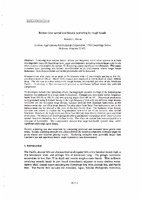| dc.contributor.author | Dicus, Ronald L. | |
| dc.date.accessioned | 2018-10-11T14:05:37Z | |
| dc.date.available | 2018-10-11T14:05:37Z | |
| dc.date.issued | 1993/08 | |
| dc.identifier | 793 | |
| dc.identifier.govdoc | CP-42/1 | |
| dc.identifier.uri | http://hdl.handle.net/20.500.12489/126 | |
| dc.description.abstract | Scattering from oceanic basalt affects low-frequency active sonar systems in at least two important ways: (1) Significant time, angle and frequency spreading reduces target echo levels when systems over-resolve the spread; (2) Scattering causes significant reverberation. This paper examines time spreading and bistatic reverberation in an environment where rough basalt dominates. Both mcasurcmenlS and model predictions will be discussed. Me,asuremenlS were made on an array of 64 elemenlS with 1/2 wavelength spacing at 160 Hz, towed at a depth of 200 m. Mk-61 SUS charges were deployed at 244 m depth in water 5000 m deep. The site was in a thin -sedimented, rough-bollom, abyssal-hill province of the Northeast Pacific. Scattering in this environment presents a continuous diffuse return (no coherent component). To investigate bottom time spreading effeclS, the magnitude-squared envelope of the bottom pulse response was analyzed for a single omni hydrophone. Comparisons were made within frequency bands from 100 Hz to 300 Hz and over grazing angles from 80° to 10°. Theoretical predictions were generated using Kirchhoff theory in the high-frequency limit with two different slope density functions: (1) the measured slope density function derived from Seabeam bathymetry at the measurement site, and (2) a slope density function taken from Deep Tow bathymetry, not at the measurement site but instead at the crest of the East Pacific Rise. The Seabeam slope density function was unable to explain the long-duration, low-level tail of the acoustic time sprc.ad functions. However, the high-resolution Deep-Tow-derived slope density function gave excellent predictions. The theoretical model appears to offer a satisfactory explanation of the observed time spread functions including their absolute levels. The effect on system loss was computed as a function of bandwidth. The computation showed that large-bandwidth systems may suffer significant additional signal losses. Bistatic scattering was also examined by comparingpredicted and measured beam power time series. Bistatic scattering strength was computed from the model as a function of bistatic angle for given source and receiver grazing angles. Scattering strengths were generally larger than Lambert's law and significant bistatic angle dependence was demonstrated. | |
| dc.format | 20 p. : ill., 16 fig. ; digital, PDF file | |
| dc.language | English | |
| dc.publisher | NATO. SACLANTCEN | |
| dc.source | In: Low frequency active sonar (SACLANTCEN Conference Proceedings CP-42), vol. 1, 1993, pp. B/7-1 - B/7-20. | |
| dc.subject | Acoustic scattering - Seafloor and sea surface | |
| dc.subject | Active sonar | |
| dc.subject | Bistatic sonar | |
| dc.subject | Modelling and environmental measurements | |
| dc.subject | Low frequency acoustics | |
| dc.title | Bottom time spread and bistatic scattering by rough basalt | |
| dc.type | Papers and Articles | |
| dc.type | Conference Proceedings (CP) | |
